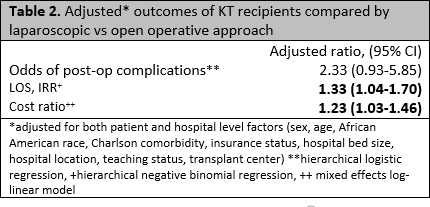Outcomes Following Appendectomy in Kidney Transplant Recipients.
Surgery, Johns Hopkins, Baltimore.
Meeting: 2016 American Transplant Congress
Abstract number: C244
Keywords: Kidney, Outcome, Surgical complications
Session Information
Session Name: Poster Session C: Poster Session 1: Kidney Complications-Other
Session Type: Poster Session
Date: Monday, June 13, 2016
Session Time: 6:00pm-7:00pm
 Presentation Time: 6:00pm-7:00pm
Presentation Time: 6:00pm-7:00pm
Location: Halls C&D
Case series suggest kidney transplant (KT) recipients have higher complication rates and longer length of stay (LOS) following appendectomy than non-transplant patients. This study investigates differences between these groups, as well as outcomes at transplant vs non-transplant centers for both laparoscopic (lap) and open appendectomy.
METHODS: The Nationwide Inpatient Sample was used to study KT recipients and non-transplant recipients who underwent appendectomy from 2000-2011. Postoperative complications were defined by ICD-9 code. Complication rates, LOS, and hospital cost were compared using hierarchical logistic regression, hierarchical negative binomial regression, and mixed effects log-linear models respectively.
RESULTS: Lap approach was used in 45% of KT recipients (n=1336) vs 55% of non-transplant patients (n=538,000). After adjustment, the use of laparoscopy did not differ significantly, (OR 0.84, 95%CI: 0.54-1.31), regardless of transplant center status (interaction p=0.16). KT recipients had a longer LOS following lap (3 vs 2d) and open (4 vs 3d) approaches (p<0.001). This differed by transplant center status (IRR 1.37, interaction p<0.001). Primary admission complication rate was higher in KT recipients following open appendectomy (22.2 vs 14.8%, p=0.009), but similar following lap appendectomy (10.6 vs 8.9%, p=0.49). Median cost was higher for KT recipients for lap ($8676 vs $7067, p <0.001) and open ($9901 vs $6306, p<0.001) approaches, and was significantly higher at non-transplant centers (ratio 1.29 95%CI 1.19-1.41, p<0.001).
CONCLUSION: KT recipients have better outcomes with lap approach regardless of center type. Cost for KT recipients is significantly higher at KT centers and length of stay is longer. KT recipients should undergo lap appendectomy when feasible at a non-transplant center to optimize outcome while decreasing cost and LOS. 

CITATION INFORMATION: DiBrito S, Olorundare I, Landazabal C, Segev D, Dagher N. Outcomes Following Appendectomy in Kidney Transplant Recipients. Am J Transplant. 2016;16 (suppl 3).
To cite this abstract in AMA style:
DiBrito S, Olorundare I, Landazabal C, Segev D, Dagher N. Outcomes Following Appendectomy in Kidney Transplant Recipients. [abstract]. Am J Transplant. 2016; 16 (suppl 3). https://atcmeetingabstracts.com/abstract/outcomes-following-appendectomy-in-kidney-transplant-recipients/. Accessed July 1, 2025.« Back to 2016 American Transplant Congress
